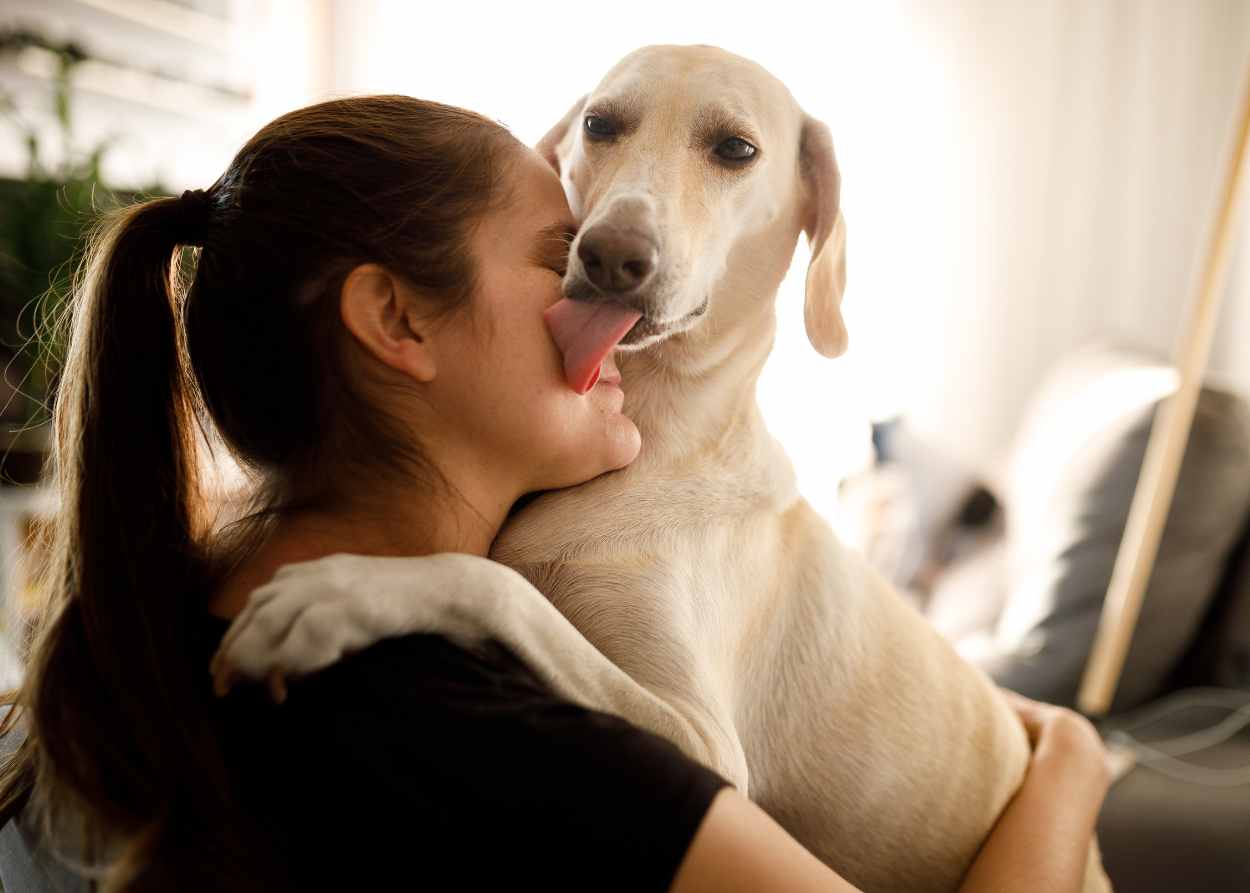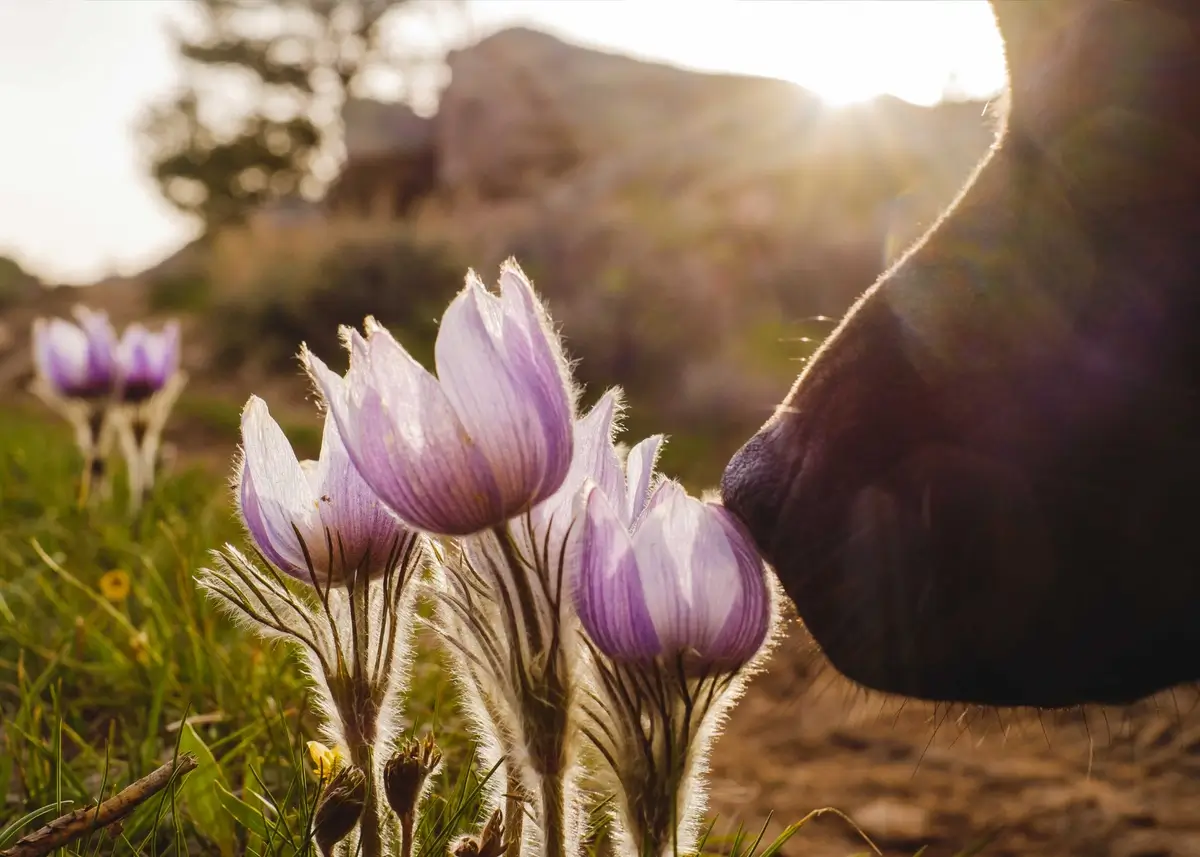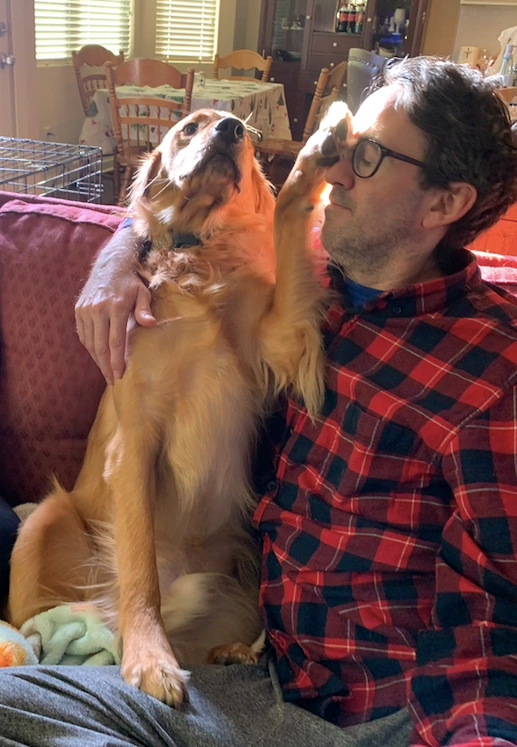You’re on a lovely picnic on a beautiful day at the local park. Your Golden Retriever thinks she’s a lapdog and has plopped down in your lap, rendering you unable to move. While she loves the cuddles, she really wants that bacon on your BLT sandwich, getting a little too close when she sniffs it. You break off a piece, and she relishes the taste of such a treat. She paws you when you stop petting her, asking (no, demanding) you give her more “scritches.” Suddenly, you see her body language change, and you notice her tense up while looking in a particular direction, poised to investigate.
“What do you hear? I don’t hear anything!” you ask your dog. Not even the tasty bacon can lure her attention back to you.
Unfortunately, your dog can’t talk, but you are dying to know what that noise was!
In this scenario, your dog used her five senses to interact with her environment. Many of us have been in a situation where our dog demonstrates experiencing the world through the same five senses but completely differently from how humans do.
You already know a dog has an amazing sense of smell and hearing abilities, but what about the other senses? Do dogs experience a “sixth sense” phenomenon? Can they see in color or hear things we can’t? And what do recent research studies reveal about our canine friends’ senses?
Discover how dogs use their five senses to experience their everyday life and interact with the world around them.
How the Five Senses Work in Puppies
The five senses in animals are necessary for collecting information about the environment, recognizing other animals as individuals, and forming decision-making skills. We’ll learn how puppies process each sense, scientific findings, and how to encourage your puppy to explore their five senses.
Smell
A dog’s sense of smell is quite the “scent”sation and superior to a human’s ability to gather information through scents. While humans have around 5 million olfactory receptors, dogs can have up to 300 million scent receptors, processing smells 40 times greater than humans can. In addition, their brains can store scent information the way a computer does thanks to how developed the nerves from their noses have evolved.
Just how powerful is a dog's sense of smell? Researchers in a 2014 study discovered that medical detection dogs could detect minuscule traces of different diseases’ odors at around one part per trillion with near-perfect accuracy. To put this number in perspective, it’s like smelling one teaspoon of a substance in 20 Olympic-sized swimming pools!
Humans can benefit from a dog’s amazing sense of smell to aid us in daily tasks when trained. In addition to the ability to detect medical issues better than human-made instruments, their olfactory abilities are useful in a variety of fields, such as hunting, search and rescue, airport and border security, bomb detection, invasive species detection, and other endeavors.
You’ve probably noticed your dog is even more interested in you if you come home smelling like another dog. It’s also uncanny how they love to grab your extra stinky socks and get into the nastiest trash and animal waste they can find. But why is that? Dogs are attracted to intense smells thanks to neophilia in dogs, the ability to be attracted to new experiences because they are naturally inquisitive animals.
Dogs gather all sorts of information through their incredible olfactory senses in several different ways. Pheromones are secretions that carry important information to others and cause responses through scent. Dog sweat is comprised of two types of gland secretions: Merocrine glands and apocrine glands. Sweat can help a puppy regulate its temperature through the merocrine glands on paw pads, while apocrine gland sweat releases scent pheromones in dogs to help them identify each other. For example, you’ve felt your dog tug you toward a fire hydrant to check out which canines have relieved themselves on it. You may be surprised to learn that dogs communicate with each other through urine, often humorously called “pee-mail.” Your dog is gathering a lot of information from these pheromones in dog urine:
- Male or female?
- What does it eat?
- Is the dog in heat?
- How old is this dog?
- Is this dog sick or stressed, happy or aggressive?
- Social status: A big dog on campus or the underdog?
You may have also noticed dog breeds renowned for their amazing sense of smell have long, floppy ears. This design serves a purpose – scents are trapped in the ears, keeping them close to the dog’s nose. Scenthounds, Retrievers, Spaniels, Setters, and other dogs historically bred to sniff out prey and quarry often have long ears, including dog breeds like Basset Hounds, Bloodhounds, Beagles, Cocker Spaniels, Mini Dachshunds, and Afghan Hounds.
To tap into your dog’s olfactory prowess, take them on a scent walk for dogs where you allow them to meander on a long leash and sniff to their heart’s content. It’s a great activity to stimulate their brains and an effective way to meet their daily mental stimulation needs. After all, the fire hydrant will “speak” to them, chirping, “You’ve got pee-mail!”
Hearing
Dogs utilize their hearing abilities to detect, identify, and find particular sounds. You might know that a dog can hear a high-pitched dog whistle but a human can’t – an adult human cannot hear over 20,000 Hz, but a dog can hear much higher pitches of frequency as high as 47,000 to 65,000 Hz. In addition to frequency, dogs can also detect a lower range of decibels which measure the loudness and softness of sound.
The mechanics of a dog’s ears allow them to hear much better than a human can. The shape of a dog’s ears called pinnae depends on the breed and their historical working origins. Regardless of shape, the pinnae act like a funnel, amplifying the hearing abilities of the small bones in the middle ear. The size and shape of the pinnae differ depending on the breed. The bigger and taller the pinnae, the greater the sound amplification. For example, Chihuahuas, French Bulldogs, Pembroke Welsh Corgis, and other small dogs are more sensitive to higher and lower frequency sounds due to the proportion of their enormous ears to their tiny bodies. Dogs can also rotate their ears and move them independently, allowing them to hone in on a noise better than our fixed, flat ears can.
Some people swear a dog has a “sixth sense,” but in reality, they just have stellar hearing abilities. Research from the University of British Columbia suggests dogs can predict when an earthquake is imminent and alert humans to take appropriate measures because they pick up the high-pitched sounds of rocks scraping together deep in the earth.
Proper ear care for dogs is essential to their ability to hear clearly and accurately. Make sure you are keeping up with ear care to prevent a healthy ear environment free of dirt, debris, wax, bacteria, infection, and hair blockage.
Sight
Some of us swear our dogs understand our moods just by looking at us. You may have gotten into a friendly staring contest with your puppy or noticed him maintaining eye contact with you when he wants a treat. Dogs watch us closely and interpret our expressions and body language, forming a deep bond with us. A dog staring at you could indicate curiosity, attention, or a desire for interaction. However, if accompanied by other aggressive behaviors like growling, stiff posture, or showing teeth, it may signal aggression and should be approached cautiously.
Puppies' vision undergoes significant development during their early weeks of life, as they are born with their eyes closed but open by the first 2 weeks. Their vision is blurry and underdeveloped and rapidly improves as they grow. Although puppies' vision is not as sharp as that of adult dogs or humans, they can still perceive shapes, movement, and distances. This ability enables them to track objects, such as toys or littermates, as they play and explore their surroundings.
You may wonder if dogs see in color, but we can turn to research to determine the answer. Jay Neitz, an ophthalmologist at the University of California, Santa Barbara at the time, found that dogs have two cones (color-sensing receptors) instead of three like humans do, meaning they are colorblind when born and cannot see reds or greens. Instead, dogs see the world in shades of yellow and blue and can’t distinguish among other colors. However, they can still see contrasts and patterns. Scientists also found that while they have one less cone, they have more rods, the cells that help with night vision. Dogs can detect light six times darker than humans can. These special rods are located behind the retina, causing your dog’s eyes to “glow” and reflect in the dark!
Touch
Just like humans, puppies receive information about their environment through touch. Through tactile exploration, they gather essential information about their environment, objects, and other beings. Researchers have studied where the information about touch is received in a puppy’s brain. They concluded almost 40% of that area in the brain is solely from touch information from the face. Of that 40%, a significant part comes from whiskers from the upper jaw and is mapped to a specific location in their brains. A dog’s whiskers are sensitive to touch and vibrations, picking up on an object’s size and location without physically touching the object.
From the moment they are born, puppies use touch to locate their mother's warmth and nourishment, fostering early bonds and security. This input helps them understand the properties of different materials and aids in the development of motor skills and coordination. Instead of fingers, dogs navigate the world on their toes, relying on receptors in their paw pads that tell them about temperature, vibrations, and surface stability.
Puppies also learn about human touch through gentle handling and affection from their caregivers. In return, we’ve all had our dogs paw at us for a treat, nuzzle us for scratches, put their heads on our legs, or try to sit on our laps (no matter what their size). Positive tactile experiences with humans contribute to the development of trust and confidence, shaping their future relationships with people.
Humans can assist puppies in learning about touch through environmental exposure and interaction. For example, allowing them to walk on different surfaces like grass, carpet, linoleum, hardwood floors, or concrete helps prepare them for life outside their mothers. They can also begin to learn gentle touch and bite inhibition by playing with littermates and older dogs. You can also help prepare your puppy for the groomer or calm them down using massage techniques, making sure to touch your puppy all over.
Taste
Puppies utilize their sense of taste as a crucial tool for exploration and learning about the world around them. From the moment they begin to nurse, puppies rely on their taste buds to experience flavors and identify their mother's milk, which provides essential nutrients for growth and development. As they transition to solid food, taste continues to play a vital role in their preferences and food intake.
Puppies also mouth and taste objects to gather information about the texture, temperature, and taste of various items – including your expensive shoes and furniture legs! Through trial and error, puppies learn what is safe to ingest and what should be avoided, helping to prevent potential harm.
While humans and dogs share taste buds to determine salty, sweet, bitter, and sour sensations, they are not as strong as ours because dogs have fewer taste buds than humans do. However, one interesting fact is that dogs have special taste buds for water located at the tip of their tongues!
We Sense You Need a Pawrade Puppy in Your Life
Pawrade offers a seamless, hassle-free secure way to adopt puppies who can’t wait to be held in your loving arms and give you puppy kisses with their little tongues. We partner with reputable breeders who give their puppies the very best start in life to prepare them for their forever homes. Our seasoned, vetted breeders know how to introduce their young puppies to all sorts of scents, sounds, sights, touches, and tastes as they develop before they come to your home to start their new life.
Get in touch with us to see the difference as you feel confident with our services. We’ll listen to your questions and provide you with all the information you need to make an informed decision about our puppies for sale. We can’t wait to hear from you!



